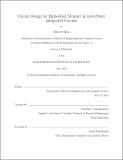Circuit design for embedded memory in low-power integrated circuits
Author(s)
Qazi, Masood
DownloadFull printable version (11.64Mb)
Other Contributors
Massachusetts Institute of Technology. Dept. of Electrical Engineering and Computer Science.
Advisor
Anantha P. Chandrakasan.
Terms of use
Metadata
Show full item recordAbstract
This thesis explores the challenges for integrating embedded static random access memory (SRAM) and non-volatile memory-based on ferroelectric capacitor technology-into lowpower integrated circuits. First considered is the impact of process variation in deep-submicron technologies on SRAM, which must exhibit higher density and performance at increased levels of integration with every new semiconductor generation. Techniques to speed up the statistical analysis of physical memory designs by a factor of 100 to 10,000 relative to the conventional Monte Carlo Method are developed. The proposed methods build upon the Importance Sampling simulation algorithm and efficiently explore the sample space of transistor parameter fluctuation. Process variation in SRAM at low-voltage is further investigated experimentally with a 512kb 8T SRAM test chip in 45nm SOI CMOS technology. For active operation, an AC coupled sense amplifier and regenerative global bitline scheme are designed to operate at the limit of on current and off current separation on a single-ended SRAM bitline. The SRAM operates from 1.2 V down to 0.57 V with access times from 400ps to 3.4ns. For standby power, a data retention voltage sensor predicts the mismatch-limited minimum supply voltage without corrupting the contents of the memory. The leakage power of SRAM forces the chip designer to seek non-volatile memory in applications such as portable electronics that retain significant quantities of data over long durations. In this scenario, the energy cost of accessing data must be minimized. This thesis presents a ferroelectric random access memory (FRAM) prototype that addresses the challenges of sensing diminishingly small charge under conditions favorable to low access energy with a time-to-digital sensing scheme. The 1 Mb IT1C FRAM fabricated in 130 nm CMOS operates from 1.5 V to 1.0 V with corresponding access energy from 19.2 pJ to 9.8 pJ per bit. Finally, the computational state of sequential elements interspersed in CMOS logic, also restricts the ability to power gate. To enable simple and fast turn-on, ferroelectric capacitors are integrated into the design of a standard cell register, whose non-volatile operation is made compatible with the digital design flow. A test-case circuit containing ferroelectric registers exhibits non-volatile operation and consumes less than 1.3 pJ per bit of state information and less than 10 clock cycles to save or restore with no minimum standby power requirement in-between active periods.
Description
Thesis (Ph. D.)--Massachusetts Institute of Technology, Dept. of Electrical Engineering and Computer Science, 2012. Cataloged from PDF version of thesis. Includes bibliographical references (p. 141-152).
Date issued
2012Department
Massachusetts Institute of Technology. Department of Electrical Engineering and Computer SciencePublisher
Massachusetts Institute of Technology
Keywords
Electrical Engineering and Computer Science.